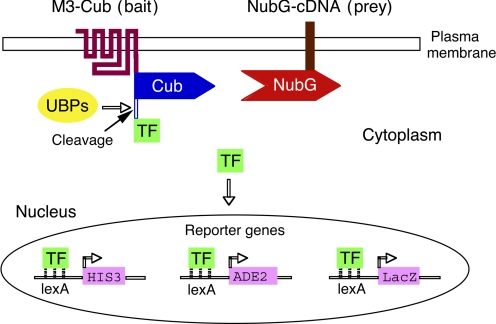Fig. 1.
Scheme of the MbYTH screen used in the present study. To obtain a bait for the MbYTH screen, we first generated a modified version of the rat M3R (M3-Cub) fused at its C terminus to the Cub domain and an artificial transcription factor (TF) (Stagljar and Fields, 2002; Iyer et al., 2005; Kittanakom et al., 2009). Potential M3-Cub-interacting proteins (preys) were expressed by a human brain cDNA library coding for proteins containing an N-terminal Nub tag. The prey can be a cytosolic protein or a membrane protein with an N terminus that is located in the cytoplasm. To decrease the likelihood of spontaneous interactions between the Nub and Cub domains, an Ile→Gly point mutation was introduced into the Nub domain (NubG) (NubG Stagljar and Fields, 2002; Iyer et al., 2005; Kittanakom et al., 2009). As a result, NubG will only efficiently interact with Cub when the two proteins to which the two tags are attached interact with each other, resulting in the formation of a NubG-Cub complex. This complex is recognized by ubiquitin-specific proteases (UBPs), which release the artificial TF from the M3-Cub construct. The TF then enters the nucleus via diffusion and binds to the lexA-binding sites upstream of the HIS3, ADE2, and LacZ reporter genes. Activation of the HIS3 gene allows for yeast growth in histidine-deficient media. The LacZ reporter provides for the colorimetric detection of Gal4p activity.

